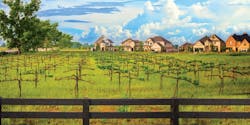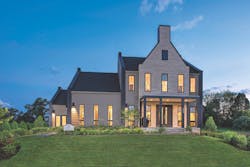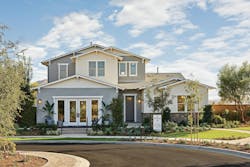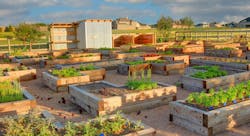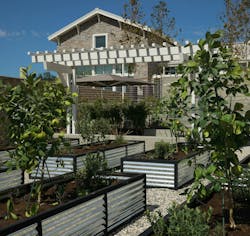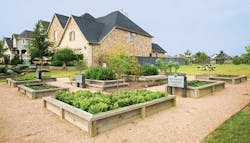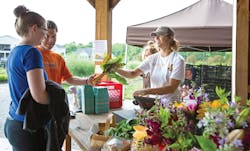Agrihoods Draw Homebuyers Back to the Land
Like accessory dwelling units and multigenerational housing, the agrihood is an old idea made new again. The Urban Land Institute defines an agrihood as a single-family, multifamily, or mixed-use community built with a working farm as a focus. It’s actually a type of conservation community (a niche that’s been around for 40 years), and it taps into the burgeoning farm-to-table movement.
Agrihood residents can participate in all kinds of farm activities, including growing and harvesting produce under the tutelage of experienced farmers; buying shares in a community-supported agriculture (CSA) program, which ensures a steady supply of produce to a homeowner’s table every week; attending cooking classes and demonstrations; and shopping at the farmers market.
A well-managed farm program also engages homeowners on a deeper level: their children’s future. Kids learn about growing and preparing their own food, enriching soil fertility, and the importance of birds and insects in the food chain.
Big-name builders such as D.R. Horton, David Weekley Homes, Lennar, K. Hovnanian Homes, Meritage Homes, and Shea Homes, along with regional and local builders, have found that agrihoods attract a wide range of buyers, from young families to affluent empty nesters. “An agrihood provides builders with the opportunity to differentiate their product offering with a unique amenity that speaks to buyer preferences for local and fresh-food sources,” says Jon Robertson, president of the Southern California division of William Lyon Homes, in Newport Beach, Calif.
K. Hovnanian Homes offers the De Zoeker model at Willowsford as part of its Line K Windmill Series. Designed in collaboration with the Dutch firm Studio Piet Boon, the home is 4,811 square feet and starts at $859,990. (Photo: Maxine Schnitzer Photography)
Willowsford: Building on Heritage
Willowsford is the only agrihood in the Washington, D.C., area. The community is made up of 4,000 acres, half of which is part of a conservancy. The property had been used over the years as pastureland for horses and cows and to grow soybeans and sod. But the 300-acre working farm that exists today was created by the developers. “We could have sold off different portions to builders, or built a golf course,” says Stacey Kessinger, VP of marketing for Willowsford, in Ashburn, Va. “But we wanted to offer more open space. We felt that the farm would unite the community and pay homage to [the farming heritage] of Loudoun County, Va.”
Deep-pocketed investors funded the construction of pools and other amenities, including the farm buildings. “The Rural Economic Development Authority, local politicians, county planners, zoning [officials] … almost everyone we interacted with was very supportive of what we were doing because we’re … not letting every last field be taken up with homes,” says Mark Trostle, VP of land development for Willowsford.
Farm director Mike Snow oversees a staff of five, plus half a dozen seasonal workers. What started as a 5-acre market garden has grown into a farm spread over several fields, says Snow: “Now we manage around 25 acres of vegetables and soil-building crops, 150 acres in pasture for animals, and the balance in woodland and future projects.”
In the six years since Snow started Willowsford Farm, his team has developed the farm stand; added animals (laying hens for eggs; broiler chickens; turkeys and pigs for meat; and goats for land management); and started producing jams, sauces, and prepared foods. Classes for adults and children are run by a renowned local chef.
The farm is currently subsidized by the developer, Kessinger says, but will eventually be self-supporting. In addition to revenue raised by vegetable and livestock production, the nonprofit Willowsford Conservancy receives a $100 yearly assessment from homeowners and 0.25 percent of each resale to help fund Conservancy and farm efforts.
As to the community’s popularity, Becky Thorpe, general sales manager for K. Hovnanian Homes, in Chantilly, Va., says, “When we started building at Willowsford, we only offered two product lines. Now we offer five, so we believe in the strength of what the community brings to this area.”
Briosa by William Lyon Homes at Esencia, the new hillside village at Rancho Mission Viejo, offers homes ranging from 3,069 to 3,486 square feet and starting from $965,000. (Photo: courtesy Rancho Mission Viejo)
Rancho Mission Viejo: The Ranch, Redefined
Rancho Mission Viejo is Orange County, Calif.’s last working ranch, encompassing nearly 23,000 acres. The property’s cattle-ranching history made it a natural fit for an agrihood, says Paul Johnson, senior VP of community development for master planner/developer Rancho Mission Viejo, in San Juan Capistrano, Calif.
“We have three farm operations: two in our first village at Sendero and the largest at Esencia,” Johnson says. Esencia Farm features a variety of in-ground row crops and fruit trees, raised planter beds, a harvest/prep barn, a greenhouse, a toolshed, a composting station, a chicken coop, and a farming demonstration/workshop courtyard.
Community farmer Gloria Broming says 100 residents are currently involved in the growing programs. The farm stand is open twice a month and sells out in two hours. Rancho Mission Viejo also started a CSA program where members can pick up a basket of fresh produce every two weeks. And, residents can reserve space at Esencia Farm for parties. The farms aren’t yet self-sustaining, Johnson says the cost of operating them “isn’t wildly expensive” compared with how well they’ve been received in the community. Amenities such as swimming pools cost more to maintain than the farms, he points out.
Homeowners at Harvest can rent garden plots for $60 to $100 per year. Twice a year, they can also participate in crop harvests in the community fields. (Photo: courtesy Hillwood Communities)
Harvest: Gardening and Giving Back
Harvest, in Northlake and Argyle, Texas, is built on land that had been farmed for generations to support cattle and crops. The area is still rural in nature, so when Dallas-based Hillwood Communities held a three-day workshop to plan the new community, the agrihood idea was a slam dunk. Hillwood created a true farm, says Angie Mastrocola, senior VP of operations and the general manager.
“We built a five-bay greenhouse and hired a professional farmer, Ross DeOtte, to grow fruits and vegetables for us,” Mastrocola says. “We also grow demonstration crops—okra, tomatoes, lettuce—and when they’re harvested, we bring in a chef who shows residents how to incorporate those ingredients in recipes.” Surplus produce is donated to the North Texas Food Bank.
DeOtte uses the Harvest greenhouses for his private farm operation, where he grows specialty lettuces and vegetables for local restaurants. In return, he manages the Harvest crops and gardens and provides education, classes, and tours for residents and schoolchildren. In addition, there are two large community crop areas that produce sizable harvests in summer and winter, Mastrocola says. Then there are the orchards, which produce apples, figs, pears, pecans, and plums. Residents can rent raised garden beds for $60 to $100 per year to grow their own food under DeOtte’s guidance.
The renovated Faught House, a 140-year-old farmhouse, is an iconic landmark in the heart of the community, with a wraparound porch that invites guests to stop by and relax. A coffee and sandwich shop will open in the Faught House in July.
Highland Homes sales counselor Anna McMellon says it’s easier to sell houses in a successful agrihood. “Not only do homeowners have the unique opportunity of knowing where their food is coming from, but there’s also a wonderful sense of community that comes from the social aspect of people sharing and trading ideas and crops,” McMellon says.
At Wallis Ranch, Trumark Homes learned that letting homeowners manage the gardens provides a sense of connection. (Photo: Christopher Mayer)
Wallis Ranch: Nature’s Way
Peter Kiesecker, COO of Trumark Communities, in Newport Beach, Calif., says the farm-to-table lifestyle has particular appeal for buyers in northern California, where nature and the outdoors have special meaning. So, Wallis Ranch, located in San Francisco’s East Bay area, has small citrus orchards and organic gardens on the main clubhouse grounds.
“Planning officials were supportive of the ‘nature infused’ aspect, from the agrihood side to managing development on sensitive riparian corridors,” Kiesecker says. “We built a 2 ½-mile-long 3-foot concrete barrier to protect the endangered California tiger salamander living in the creek.”
Wallis Ranch consists of eight distinct neighborhoods with a total of 806 homes at buildout. Sales at all eight neighborhoods started in the summer of 2016, and so far, 25 percent are sold. Maintenance of the orchards and gardens is paid for by HOA assessments. One lesson Trumark has learned, says Kiesecker, is to let the residents help plan and manage the gardens: “It makes them feel more connected.”
Harvest Green near Houston has community gardens, but homebuyers can also select a private backyard garden as an option. (Photo: courtesy Johnson Development)
Harvest Green: Houston Haven
Located near Houston is the agrihood of Harvest Green, where 11 builders offer homes priced from the $240,000s. Since the community opened in September 2015, 478 homes have been sold at an average price of $364,000, says Larry Johnson, chairman and CEO of Johnson Development, in Houston.
“Years ago the land was part of the justice system and was farmed by the inmates, so it’s been in farming mode for a number of years,” Johnson says. “[Our farm] is mostly vegetables and produce, although we have a few chickens and goats.”
Buyers are ethnically diverse, with the largest age group being between 35 and 44 with children 12 years and under, says Shay Shafie, VP of Harvest Green and general manager for Johnson Development, in Sugar Land, Texas. Most are move-ups from the Houston/Sugar Land/Richmond area.
Shafie says that the agrihood concept has been a success, with a large percentage of residents participating in the farming events and volunteering when needed. Residents enjoy a weekly on-site farmers market and a CSA program by Loam Agronomics, which delivers farm-fresh produce to their doors. Homebuyers can also opt for a private backyard garden.
Fielding at Wallis Ranch, designed by Trumark Homes and KTGY Architecture + Planning, evokes the agrarian architecture of the San Francisco's East Bay region. Homes start in the high $800,000s and range from 1,809 to 2,685 square feet. (Photo: Christopher Mayer)
Agrihood-Appropriate Architecture
What do homes in an agrihood look like? At Wallis Ranch, in San Francisco’s East Bay area, the architectural styles draw from the region’s farming and agrarian history, says Garrett Hinds, director of architecture for Trumark Homes, in San Ramon, Calif.
“Traditional farmhouse is the root style for the community, defined by simple, understated details and massing,” Hinds says. “You’ll see covered-porch elements such as 12-to-18-inch eaves, gambrel roof forms with 3-in-12 and 6-in-12 pitches, and wood columns and posts with 5-to-12-inch rakes.”
Central Coast Revival blends European and Californian farmhouse influences such as balconies, low-pitch roofs, single-hung windows, and stucco and brick siding with wood brackets and kickers.
“Americana is a compilation of colonial, Georgian, and Cape Cod styles as they’ve been interpreted in various California farm towns where many immigrants first settled,” Hinds says. “Simple colors, rectangular symmetrical massing, double-hung windows, clapboard and/or brick siding, and steeply pitched gable roofs define this broad style.”
Farm stands are just one of many potential revenue-generating activities in an agrihood. They're also an opportunity to socialize, as seen at Willowsford in Loudoun County, Va. (Photo: Bushnell Photography)
Farmer D’s Recipe for Success
Developers that undertake an agrihood with the goal of making a profit are setting themselves up for failure, says Daron “Farmer D” Joffe, a consultant based in Encinitas, Calif., who helps integrate farms into residential communities. “Making money selling vegetables on a small scale is extremely challenging, and when you add a robust community engagement element, it’s even more difficult,” Joffe says. “It takes years for a farm to become self-sustaining.”
That’s why successful community farms generate a mix of revenue streams, as outlined below. “Often there are also donations and grants and in-kind support from the developer and community outreach,” he says.
Here’s more advice from Farmer D:
- Don’t make the farm an afterthought. Think about the agricultural value of the land and its history and heritage, and tap into local farming expertise. The new farm can also take advantage of existing infrastructure and equipment.
- Make the farm accessible to the people who will use it the most. This may mean putting it close to a school, a park, or senior housing.
- Hire a farm manager who has the technical skills required to run a diverse farming operation and is also a good business manager and “people person.” But other positions, such as programming and administrative staff, are equally important.
- Make chickens, goats, pigs, and other animals part of the plan. Joffe explains that the holistic approach to farming known as biodynamic agriculture includes animals as a strategic first step, building soil fertility and improving the land in preparation for vegetable gardens and row crops.
- Plan a variety of programs such as summer camps, after-school programs, farm-to-table cooking classes, and a series of dinners with local chefs. Develop your own brand of jams or pesto sauce. Set up a food truck, an on-site restaurant, or a catering service. Start a vineyard or a nursery to sell plants to residents and the public. Offer gardening services to the surrounding area such as composting or landscape maintenance.
